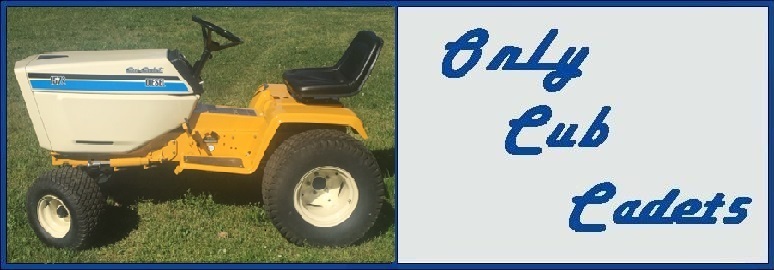
 |
PLEASE PATRONIZE OUR SPONSORS!






|
|||||||
 |
|
|
Thread Tools | Display Modes |
|
#21
|
||||
|
||||
|
Progress is always good! You're starter/generator could be getting weak but that's not a cheap fix...it would however be a good idea to remove it and clean all the mounting points on it and the engine, I could be wrong but I believe that is the grounding point, if not on your particular tractor please disregard that but I'm pretty sure! If you hook battery power directly to it and it's still slow (after cleaning the mounting points/grounds for it) it's most likely just getting tired and in need of a rebuild, you won't want to attempt this. Replacement is another option. To hook battery power directly to the starter use jumper cables and connect to the battery, then put the positive cable to the A on the starter where the, large main power wire connects to it then touch/clamp/hold ground cable to the body of it. Always hook up to the battery first and connect the positive first because "without a ground, the power will have nowhere to go". If you do it opposite sparks will fly, literally! Lol
Remember in one of my previous posts I described how battery voltage will drop while cranking the engine? It may be time to do those tests if starter spins full speed connected directly to the battery but you don't want to the engine to fire so I would remove the spark plug wire and prop it up away from metal, with something non conductive (screwdriver handle, block of dry wood ect.). You need a baseline by reading the voltage first at the battery, secure you meters ground to a good known ground and leave it there. Refer to the wiring diagram I posted previously to follow along. You only need to crank for 2-3 seconds each time to get your reading. You've tested at the battery, now test at the starter, then follow that wire and test at the starting solenoid, then to the other side of the solenoid, then follow that wire to the Ammeter (if equipped, if not test at the junction), then the other side of the ammeter, follow that wire to the B on the keyswitch, then the S on the keyswitch and then follow that to the neutral safety switch, the other side of it and you're done testing the whole starting system aside from the S/G internals which I something you may want to have a professional do. You're close to a full diagnosis or fix, keep after it!
__________________
1973 Cub Cadet 149 basketcase (Work In Progress) ~My Real Hobby Is Collecting Projects!~ |
|
#22
|
||||
|
||||
|
I didn't see if anyone mentioned it, but there are a few options for factory style wire harness replacements. When I first started restoring my 147, I had the idea to build my own. As soon as I had priced the color coded wire and then began the hunt for all the connectors I quickly realized these aftermarket replacements are worth every last dime.
At one time someone on these forums made them, or you can find them on ebay. |
|
#23
|
|||
|
|||
|
There was a guy named LaMar that made CC harnesses, and did a good job. He recently retired from doing that, due to Health reasons.
There is a company called Porch Electric that does. They are in Illinois and you can visit their Web Site at: www.porchelectric.com
__________________
[B]Roland Bedell[/B] CC Models: 100, 105, 1450, 782, (2) 784, & 2072 [SIZE="4"][B][COLOR="Red"]Buy:[/COLOR][COLOR="Blue"] Made in the USA[/COLOR][/B] [/SIZE]:American Flag 1: |
 |
|
|
Cub Cadet is a premium line of outdoor power equipment, established in 1961 as part of International Harvester. During the 1960s, IH initiated an entirely new line of lawn and garden equipment aimed at the owners rural homes with large yards and private gardens. There were a wide variety of Cub Cadet branded and after-market attachments available; including mowers, blades, snow blowers, front loaders, plows, carts, etc. Cub Cadet advertising at that time harped on their thorough testing by "boys - acknowledged by many as the world's worst destructive force!". Cub Cadets became known for their dependability and rugged construction.
MTD Products, Inc. of Cleveland, Ohio purchased the Cub Cadet brand from International Harvester in 1981. Cub Cadet was held as a wholly owned subsidiary for many years following this acquisition, which allowed them to operate independently. Recently, MTD has taken a more aggressive role and integrated Cub Cadet into its other lines of power equipment.
This website and forum are not affiliated with or sponsored by MTD Products Inc, which owns the CUB CADET trademarks. It is not an official MTD Products Inc, website, and MTD Products Inc, is not responsible for any of its content. The official MTD Products Inc, website can be found at: http://www.mtdproducts.com. The information and opinions expressed on this website are the responsibility of the website's owner and/or it's members, and do not represent the opinions of MTD Products Inc. IH, INTERNATIONAL HARVESTER are registered trademark of CNH America LLC
All material, images, and graphics from this site are the property of www.onlycubcadets.net. Any unauthorized use, reproductions, or duplications are prohibited unless solely expressed in writing.
Cub Cadet, Cub, Cadet, IH, MTD, Parts, Tractors, Tractor, International Harvester, Lawn, Garden, Lawn Mower, Kohler, garden tractor equipment, lawn garden tractors, antique garden tractors, garden tractor, PTO, parts, online, Original, 70, 71, 72, 73, 76, SO76, 80, 81, 86, 100, 102, 104, 105, 106, 107, 108,109, 122, 123, 124, 125, 126, 127, 128, 129, 147, 149, 169, 182, 282, 382, 482, 580, 582, 582 Special, 680, 682, 782, 782D, 784, 800, 805, 882, 982, 984, 986, 1000, 1015, 1100, 1105, 1110, 1200, 1250, 1282, 1450, 1512, 1604, 1605, 1606, 1610, 1615, 1620, 1650, 1710, 1711, 1712, 1806, 1810, 1811, 1812, 1912, 1914.